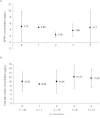Tear levels of SFRP1 are significantly reduced in keratoconus patients
- PMID: 23441124
- PMCID: PMC3580972
Tear levels of SFRP1 are significantly reduced in keratoconus patients
Abstract
Purpose: To measure secreted frizzled-related protein 1 (SFRP1) levels in human tears and to investigate tear SFRP1 as a potential biomarker for keratoconus (KC).
Methods: Tears were collected from control (n = 33) and KC patients (n = 33) using micropipette tubes. Total tear protein was measured using a FluoroProfile Protein Quantification kit. An in-house enzyme-linked immunosorbent assay (ELISA) was developed to measure SFRP1 in control and KC tears. Statistical analyses of age, gender, the association of SFRP1, and total tear protein with KC were conducted.
Results: Tear SFRP1 was significantly decreased in KC, compared to age-matched controls (3.41 ng/μl ± 3.12 versus 5.55 ng/μl ± 5.62, respectively; p = 0.039). Conversely, total tear protein was significantly increased in KC, compared to age-matched controls (12.38 μg/μl ± 4.76 versus 9.40 μg/μl ± 3.88, respectively; p = 0.038). The ratio of SFRP1/total tear protein was also found to be significantly decreased in the KC group (p = 0.007). No significant association between tear SFRP1 and total tear protein was detected.
Conclusions: Tear SFRP1 was significantly decreased in age-matched KC versus control patients, and may be further reduced in moderate KC. Tear-SFRP1 levels alone do not provide an obvious biomarker for KC; however, our results provide further evidence that tear-protein profiles are altered in KC, and suggest the involvement of SFRPs in the pathogenesis of KC.
Figures



References
-
- Rabinowitz YS. Keratoconus. Surv Ophthalmol. 1998;42:297–319. - PubMed
-
- Kymes SM, Walline JJ, Zadnik K, Gordon MO. Quality of life in keratoconus. Am J Ophthalmol. 2004;138:527–35. - PubMed
-
- Romero-Jiménez M, Santodomingo-Rubido J, Wolffsohn JS. Keratoconus: a review. Cont Lens Anterior Eye. 2010;33:157–66. - PubMed
-
- Sutton G, Madigan M, Roufas A, McAvoy J. Secreted frizzled-related protein 1 (SFRP1) is highly upregulated in keratoconus epithelium: a novel finding highlighting a new potential focus for keratoconus research and treatment. Clin Experiment Ophthalmol. 2010;38:43–8. - PubMed
-
- Kawano Y, Kypta R. Secreted antagonists of the Wnt signalling pathway. J Cell Sci. 2003;116:2627–34. - PubMed
Publication types
MeSH terms
Substances
LinkOut - more resources
Full Text Sources
Medical
Research Materials
